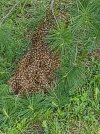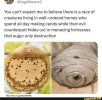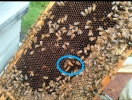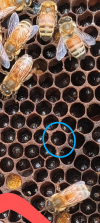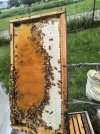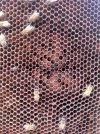I still need to come up there and get some honey.
You are using an out of date browser. It may not display this or other websites correctly.
You should upgrade or use an alternative browser.
You should upgrade or use an alternative browser.
My sweet honey at C81
- Thread starter 455 Bravo Uniform
- Start date
kaiser
Pattern Altitude
- Joined
- Mar 6, 2019
- Messages
- 2,447
- Location
- Chicagoland
- Display Name
Display name:
The pilot formerly known as Cool Beard Guy
Can't help but hear that Tom Petty song each time I click this thread.
455 Bravo Uniform
Final Approach
Thanks for the update. I’m deep into reading and learning. Might join a club. I’ve been looking into downsides of the Layens style hives. I’ll probably wait until next spring to start just because I feel like I’m behind the curve.
455 Bravo Uniform
Final Approach
Questions for @Racerx or others familiar with bees, as a potential new beekeeper in the future;
-If you split hives to prevent overcrowding, don’t you eventually run out of time and money because you’re doubling your hives every so often?
-Assuming you keep hive height reasonable adding only a few boxes, are splits typically done once a year? I realize some of this is related to pollen and nectar flows, but in general is this correct?
-If you limit the number of hives you manage, and you don’t spilt, they will swarm, right? Can you just naturally let them leave, and the half left behind will raise a new queen, with all the brood, honey, and comb that’s already there?
-if all we do is split hives and prevent swarms, then genetically won’t the swarm genes start faltering? Maybe silly.
-If you split hives to prevent overcrowding, don’t you eventually run out of time and money because you’re doubling your hives every so often?
-Assuming you keep hive height reasonable adding only a few boxes, are splits typically done once a year? I realize some of this is related to pollen and nectar flows, but in general is this correct?
-If you limit the number of hives you manage, and you don’t spilt, they will swarm, right? Can you just naturally let them leave, and the half left behind will raise a new queen, with all the brood, honey, and comb that’s already there?
-if all we do is split hives and prevent swarms, then genetically won’t the swarm genes start faltering? Maybe silly.
The bees need space for brood and honey. You can split a hive and create another hive with the split. Or you can keep stacking honey supers to prevent them from swarming. All in what your goal is. I'll typically only have 2 deeps and 2 supers. If they need more room I'll take the bottom super and harvest and replace with fresh super depending on the flow. Otherwise it gets to tall.Questions for @Racerx or others familiar with bees, as a potential new beekeeper in the future;
-If you split hives to prevent overcrowding, don’t you eventually run out of time and money because you’re doubling your hives every so often?
-Assuming you keep hive height reasonable adding only a few boxes, are splits typically done once a year? I realize some of this is related to pollen and nectar flows, but in general is this correct?
-If you limit the number of hives you manage, and you don’t spilt, they will swarm, right? Can you just naturally let them leave, and the half left behind will raise a new queen, with all the brood, honey, and comb that’s already there?
-if all we do is split hives and prevent swarms, then genetically won’t the swarm genes start faltering? Maybe silly.
Generally swarm season is late april-mid june. I'll only split a hive during that time as I want to give the split enough time to build up there numbers and honey stores for the winter. When you split without a mated queen to release it's going to be 6 weeks ish before the new queen's brood starts hatching. It's 14-16 days for new queen to hatch. 7-10 days before she's mated. A few days to start laying eggs. And 21 days for workers to emerge from egg to bee. During that time the bees that are there have nothing to do but collect nectar and pollen. So you have to make sure they don't get honey bound and there's a place for the queen to lay when she's ready. But you're bee numbers will start to decline so I usually supplement with a frame or 2 from another hive to build it up faster.
Theres not really swarm genes. The Russians tend to swarm easier. But bees want to swarm when they're out of space. Like people....is there such a thing as too much garage space? When we're out of space what do we do? Build a pole barn. When the pole barn is full we start packing the airplane hangar. Now with bees there's a theory of "demoralizing" where if you give them too much space too soon they won't build as fast. So the rule is 80%. When theyre working 8 frames of a 10 frame box, stack another.
When you buy a package of bees, you might get bees from 10 different hives shaken together then into a funnel into the package box. It's been like that for decades and bees still swarm when they're bound up.
When swarms do happen, it looks like a bee tornado for 30 minutes. Really cool to see. Scares the crap out of everyone else though. You can usually follow them to see where they land as it usually won't be far, at least right away. Sometimes they'll move later on.
It's rare for a swarm to happen in July. There's a nectar dearth so the bees typically have space as they're consuming honey the same pace or faster than they're bringing in nectar. They're also a little more feisty this time of year since there's not much to do.
One thing I will do later than swarming season is start a nuc. So I have spare queens on hand. But that's only taking 1 frame out. Might take one frame out of 3 different hives. When they build out on those, I'll put those frames from a nuc into a weaker hive.
Last edited:
- Joined
- Mar 31, 2019
- Messages
- 5,988
- Location
- Knee deep in a Lycoming
- Display Name
Display name:
Richard Digits
So bees will just live in a different hive if you put them there? I always assumed they were "loyal" for lack of a better term, to their queen (mother) and sisters.
- Joined
- Mar 10, 2013
- Messages
- 19,575
- Location
- Oakland, CA
- Display Name
Display name:
Bro do you even lift
oh heeeeeeeeeeeell no. what state is that in? I'll make sure I'm out of town fo sho.
- Joined
- Mar 31, 2019
- Messages
- 5,988
- Location
- Knee deep in a Lycoming
- Display Name
Display name:
Richard Digits
Believe me, there are FARRR worse things in illinois.oh heeeeeeeeeeeell no. what state is that in? I'll make sure I'm out of town fo sho.
- Joined
- Mar 10, 2013
- Messages
- 19,575
- Location
- Oakland, CA
- Display Name
Display name:
Bro do you even lift
Believe me, there are FARRR worse things in illinois.
You mean, like, one-legged prostitutes?
- Joined
- Mar 31, 2019
- Messages
- 5,988
- Location
- Knee deep in a Lycoming
- Display Name
Display name:
Richard Digits
Generally speaking, the fewer legs, the scarier.You mean, like, one-legged prostitutes?
When they swarm like this the old queen is in the middle of the cluster somewhere. Clip the branch and shake em in a hive and you should have the queen in there. Close the box up and see if the ones out foraging or the ones that didn't make it in the box try to make their way into the new hive. If you see a cluster at the entrance, they smell the queens pheromones and know she's in there and want in.So bees will just live in a different hive if you put them there? I always assumed they were "loyal" for lack of a better term, to their queen (mother) and sisters.
Putting already drawn frames in the new hive will make it more attractive for the queen to want to stay. Once she starts laying they won't leave. If you've got a couple frames of honey even better. Less work for them compared to building comb off a pine tree branch. Which is why they'll frequently leave the initial swarm spot after a day or so. Not a good spot and a lot of work to make it "home"
Last edited:
2-Bit Speed
Pattern Altitude
- Joined
- Nov 9, 2021
- Messages
- 1,556
- Display Name
Display name:
2-Bit Speed
- Joined
- Mar 10, 2013
- Messages
- 19,575
- Location
- Oakland, CA
- Display Name
Display name:
Bro do you even lift
Do you know all their names?
According to the county, I'm a bee farmer....we don't name the livestock.Do you know all their names?
- Joined
- Mar 31, 2019
- Messages
- 5,988
- Location
- Knee deep in a Lycoming
- Display Name
Display name:
Richard Digits
Ok the second pass around my yard on the mower, I saw this:


About a foot from where my head was on the first pass. I'm not a beekeeper, but I am bee-curious. This is obviously a swarm, yes? Probably split off from the aforementioned "hackberry hive" that's about 50' away? How long will they hang out there? Will they inhabit another hollow tree in my yard, my house, or go further away? I'm amazed the tree hive would split this fast... Or do hives regularly create swarms healthy or not? At this point I'm tempted to go buy some boxes and a suit. Just what I need is another hobby.


About a foot from where my head was on the first pass. I'm not a beekeeper, but I am bee-curious. This is obviously a swarm, yes? Probably split off from the aforementioned "hackberry hive" that's about 50' away? How long will they hang out there? Will they inhabit another hollow tree in my yard, my house, or go further away? I'm amazed the tree hive would split this fast... Or do hives regularly create swarms healthy or not? At this point I'm tempted to go buy some boxes and a suit. Just what I need is another hobby.
455 Bravo Uniform
Final Approach
I've had bees in the plane before....but today is a bit windy. Plus I don't know if I've got enough equipment to add another hive. I think I'm at 22 total. Not including nucs.@Racerx a short flight for ya
Most likely a swarm from the hackberry. That's typically what they do when they swarm. Ran out of space, they start making a ton of queen cells. First queen emerges, old queen takes 50-60% of the colony to a spot where scout bees picked. Usually pretty close to the old colony. When they swarm it looks like a tornado. Scary looking. But once it's over, they're really docile.
Typically, theyll stay there for a couple days....unless the spot is deemed suitable for the colony to thrive. I would probably expect them to bolt in a couple days. A Few years ago I found the remnants of what would have been a swarm in a tree 30' up and only cuz all the leaves were gone. Unfortunately it was spring and they didn't make it....even if I could have gotten to them. So they could stay.
Call your neighbor that has bees. They'll be really docile right now. No suit needed. Clip the branch so it's just the cluster. Take out a few frames of a boxy and put the branch and cluster in. Leave box in the yard overnight so any bees out foraging smell that the queen is in the hive. Pick hive up the next morning.
Last edited:
If you need any advice feel free to pm and ill give you my number. Fascinating little creatures that I had no intent on learning about....but here I am a full on beek....bee geekOk the second pass around my yard on the mower, I saw this:
View attachment 129670View attachment 129671
About a foot from where my head was on the first pass. I'm not a beekeeper, but I am bee-curious. This is obviously a swarm, yes? Probably split off from the aforementioned "hackberry hive" that's about 50' away? How long will they hang out there? Will they inhabit another hollow tree in my yard, my house, or go further away? I'm amazed the tree hive would split this fast... Or do hives regularly create swarms healthy or not? At this point I'm tempted to go buy some boxes and a suit. Just what I need is another hobby.
- Joined
- Mar 31, 2019
- Messages
- 5,988
- Location
- Knee deep in a Lycoming
- Display Name
Display name:
Richard Digits
So I find myself seriously considering running up town and getting a hive box. Here's the question... how much work is it? Watching the wild hive take care of itself makes me think that they're more self sufficient than I realized.If you need any advice feel free to pm and ill give you my number. Fascinating little creatures that I had no intent on learning about....but here I am a full on beek....bee geek
For one hive, once it's put together....15 minutes once a week if you look at every frame and try to find the queen...which isn't necessary. The nectar flow has tapered off so you could probably go every other week once they're established and you know the queen is there.So I find myself seriously considering running up town and getting a hive box. Here's the question... how much work is it? Watching the wild hive take care of itself makes me think that they're more self sufficient than I realized.
I open my hives once a week. This time of year I'm starting to be less concerned about swarming, but still want to make sure they've got room. The rule of thumb is when they're working 8 out of 10 frames, add a box.
If they've got room, I'm looking for recent evidence of the queen. Often I'll pull one frame, see eggs and fresh brood, button it up and move on. Picture shows the egg.... And the queen is right there.
There's different types of frames. Plastic, wood with plastic foundation, and wood with wax foundation. Foundation just has the cell embossed into it. I like wax foundation as the plastic doesn't always have a uniform wax coating and the bees sort of reject it and build burr comb which is just drones.
Open hive. Working 8 or fewer frames. Pull frame see that white speck of an egg. Close it up you're done.

- Joined
- Mar 31, 2019
- Messages
- 5,988
- Location
- Knee deep in a Lycoming
- Display Name
Display name:
Richard Digits
Called my beekeeper neighbor. He brought a box and some sugar water and got them in. We'll see what happens. He said he'd help me get started. He also said that small of a swarm will have to be fed to have any chance of making it through the winter. Guess I finally have an answer for when people ask if I have any livestock.



455 Bravo Uniform
Final Approach
That swarm looked pretty big to me, but I’m only now starting to learn about bees.
- Joined
- Mar 10, 2013
- Messages
- 19,575
- Location
- Oakland, CA
- Display Name
Display name:
Bro do you even lift
I think if you're a beekeeper you can claim your land as farmland and get a tax break!!Called my beekeeper neighbor. He brought a box and some sugar water and got them in. We'll see what happens. He said he'd help me get started. He also said that small of a swarm will have to be fed to have any chance of making it through the winter. Guess I finally have an answer for when people ask if I have any livestock.
That's the ONLY reason I do it.I think if you're a beekeeper you can claim your land as farmland and get a tax break!!
It actually looked like a decent size swarm. Feeding isn't a bad idea. The nectar flow is pretty well done and the fall flow can be hit or miss. Rain can wreak havoc on the fall flow.Called my beekeeper neighbor. He brought a box and some sugar water and got them in. We'll see what happens. He said he'd help me get started. He also said that small of a swarm will have to be fed to have any chance of making it through the winter. Guess I finally have an answer for when people ask if I have any livestock.View attachment 129711View attachment 129713
Welcome to the hobby!
- Joined
- Mar 2, 2005
- Messages
- 15,276
- Location
- Southeast Tennessee
- Display Name
Display name:
This page intentionally left blank
- Joined
- Mar 10, 2013
- Messages
- 19,575
- Location
- Oakland, CA
- Display Name
Display name:
Bro do you even lift
- Joined
- Mar 31, 2019
- Messages
- 5,988
- Location
- Knee deep in a Lycoming
- Display Name
Display name:
Richard Digits
My neighbor says he thinks 60% of his honey comes from soybeans. He says when they start blooming his bees starting making honey like crazy, so hopefully they'll be established by then and can make some progress.It actually looked like a decent size swarm. Feeding isn't a bad idea. The nectar flow is pretty well done and the fall flow can be hit or miss. Rain can wreak havoc on the fall flow.
Welcome to the hobby!
Alfalfa honey is really good. Just saying.My neighbor says he thinks 60% of his honey comes from soybeans. He says when they start blooming his bees starting making honey like crazy, so hopefully they'll be established by then and can make some progress.
- Joined
- Mar 31, 2019
- Messages
- 5,988
- Location
- Knee deep in a Lycoming
- Display Name
Display name:
Richard Digits
We're friends with the owners of Curtis orchard in Urbana. She keeps bees in the apple orchard there and that is the best honey I've ever had by an order of magnitude.Alfalfa honey is really good. Just saying.
I'm skeptical of the monofloral honey's. Bees range up to 3miles from the hive.
My neighbor has an alfalfa field. The problem is alfalfa is usually grown for hay and it's always cut down just before it flowers as it loses nutritional value to the livestock.
In the fall when the golden rod flow is on, hives smell like sweaty gym socks while they dry the nectar down. But bees are working more than just goldenrod
My neighbor has an alfalfa field. The problem is alfalfa is usually grown for hay and it's always cut down just before it flowers as it loses nutritional value to the livestock.
In the fall when the golden rod flow is on, hives smell like sweaty gym socks while they dry the nectar down. But bees are working more than just goldenrod
Gets 1 beehive and is suddenly a honey connoisseur.We're friends with the owners of Curtis orchard in Urbana. She keeps bees in the apple orchard there and that is the best honey I've ever had by an order of magnitude.
Pretty good list of nectar sources and if they're minor or major sources.

List of Northern American nectar sources for honey bees - Wikipedia
455 Bravo Uniform
Final Approach
It would be interesting to farm indoors with various crops and hives and do taste testing.
JOhnH
Touchdown! Greaser!
I think that is called a "bee ball". There is probably a female in the middle of that swarm of males. If you don't believe me, look up "bee ball".Ok the second pass around my yard on the mower, I saw this:
View attachment 129670View attachment 129671
About a foot from where my head was on the first pass. I'm not a beekeeper, but I am bee-curious. This is obviously a swarm, yes? Probably split off from the aforementioned "hackberry hive" that's about 50' away? How long will they hang out there? Will they inhabit another hollow tree in my yard, my house, or go further away? I'm amazed the tree hive would split this fast... Or do hives regularly create swarms healthy or not? At this point I'm tempted to go buy some boxes and a suit. Just what I need is another hobby.
Even male bees are a bunch of horny dogs.
No, that's a cluster or swarm and almost all are females with one single mated queen in the middle the workers (females) attend to. Less than 10% of the hive are male or drones. Drones do not collect nectar. They do not raise brood. They eat honey and fly in areas called drone congregation areas. Hoping a virgin queen goes to that area to mate.I think that is called a "bee ball". There is probably a female in the middle of that swarm of males. If you don't believe me, look up "bee ball".
Even male bees are a bunch of horny dogs.
Worker bees are females but do not mate.
1 in 1,000 drones will mate in his lifetime. But mating also means death. Which I suppose is a pretty good way to go. Until you find out Queens breed with an average of 12 drones. So sloppy twelfths and death due to their endophallus (you figure it out) breaking off during the mating process.
Anyone signing up? Buehler?


